Table of Contents
This post has been updated in October of 2023 to include the most up-to-date information and new train sets about beginner model trains for 2023.
What are model trains?
If you’re on this page, chances are good you already have a rough idea what model trains and model railroads are. But for the uninitiated, they’re small, life-like versions of real trains that hobbyists build detailed tracks for.
So why on earth do they do this? Well, it’s the same reason as any other hobby. It’s enjoyable!
People have different reasons for getting into the model railroad hobby; some people like it because they’re train or locomotive enthusiasts. Others get into it for the building aspect and enjoy creating fantastical dioramas. And others get into it for the social aspect of meeting up with like-minded people and showing off their locomotives and being part of a group.
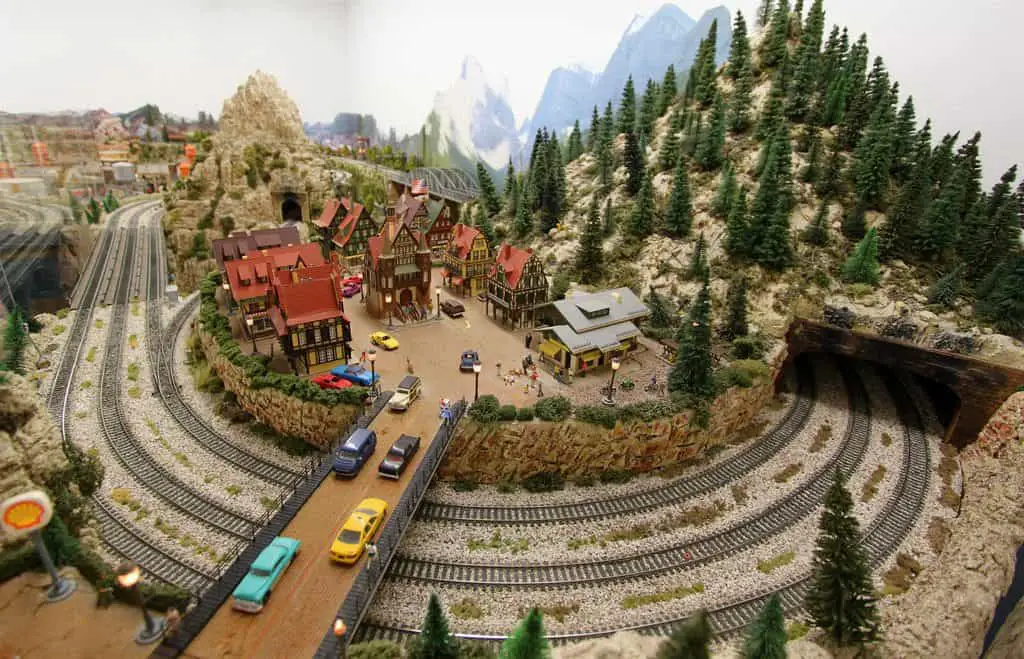
Model trains come in all shapes, sizes, brands and styles. So it’s really a great hobby to get into because there are so many options. There are also models that cost $20 and models that cost $1,200 so it is beginner, intermediate and advanced friendly! Although money doesn’t dictate skill level, it’s pretty true of model trains that the more you pay the better detail you’re going to get. For a beginner, the $100-200 is sort of an entry-level price!
Want to jump straight into the purchase? Take a look at our Best Electric Model Train Guide!
What’s the history of model trains?
The earliest type of model trains has been around since the 1840’s with the invention of the ‘carpet railway’ trains. So model trains have been around for longer than any of us have been alive! These were rudimentary brass trains that were steam-powered and didn’t have a track to go around. They’d just run across the carpet or floor, hence the name.
In 1891 a company called Marklin launched the first version of what we’d consider a model train kit from today. It was a series of railroad tracks, different locomotives as well as accessories like tunnels and buildings to match, all ready to go.
It wasn’t until the 1920’s that model railroading really becomes a hobby for the every-man, and not just for rich enthusiasts. This was also the time that most manufacturers switched over from steam-powered to electric train tracks.
Over the next 100 years, model trains would continue to get better with the advent of better manufacturing methods. And as different companies rose and fell, the advent of certain scales and gauges across the industry took shape until you see what we have today.
In recent years new scales have continued to pop up, with things like large G scale locomotives, as well as small N or Z scale trains, but HO and O scale trains remain the dominant scale.
What are the common scales and gauges of model trains?
Scales and Gauges are the industries way of defining what size the model trains are and what size the tracks are. There is still a little bit of incompatibility between UK models and American models, so always double check with the company you purchase from.
A scale is usually defined as a number like 1:87 for HO scale trains, or 1:22.5 in the case of G scale.
But what’s that actually mean?
Well, the 1 represents a full sized train, and the second number like 87, means that it’s 87 times smaller.
So in the case of N scale that’s 1:160, it’s a tiny train because it’s 160 times smaller than a full-sized locomotive. This means they’re about the size of your finger! Whereas the G scale trains that are only 22 times smaller are considered ‘Garden Trains’ because they’re normally too big for indoors.
What the hell is a gauge then, you ask?
Well, a gauge is just a fancy way of saying how big the width of the train track is. So HO scale trains that are 1:87 normally run on a track gauge of 1.75 inches across. Some companies and train production vary slightly and will be reflected in their specs. A good example is the trains that run on a ‘Narrow Gauge’ to reflect their real-world counterparts. While O scale trains runs on 1:48 and a 1.25-inch gauge, an O scale train that uses Narrow Gauge is still 1:48 but runs on about half the gauge, which means it normally runs on HO scale train tracks.
Want some more information about the different sizes? Check out our Model Train Scales Explained post! Or, if you’re a beginner, have a look at our Best Beginner Train Scale post.
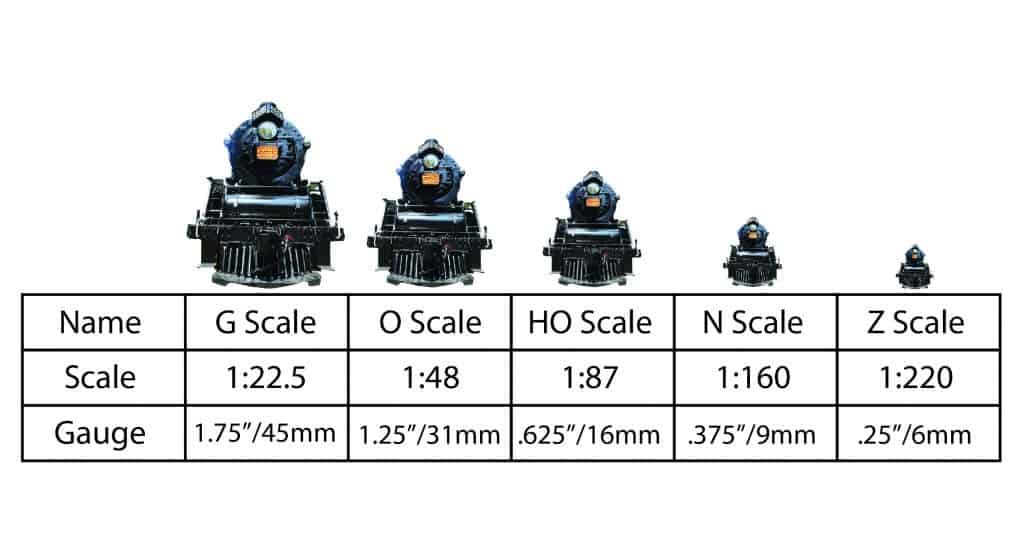
How do model trains work?
So how exactly do model trains work? Well, it’s once again really simple and really complicated. Most model trains run using electricity these days. So for an electric train, a power unit is attached to the train tracks and will send either a negative or positive amount of amps or electricity to the train. From there, the train’s engine interprets that and will go forwards or backwards, and can change speed depending on the number of amps it receives.
That’s the simple version! So really, all you need is a length of rail-track, a train and a power unit to get yourself going.
From there, you can get really complicated, especially with DCC train control systems that allow for more input. They can go forward, backwards, run multiple trains, speed up or slow down, blow your horn or whistle and control any lights you have.
Other trains will run on things like steam, which operate in the same way a real train does. Conductors will add in fuel like speciality bricks that burn and heat up the engine. From there it creates steam that powers the engine. The trick here is to maintain a constant temperature. Too cold and it moves slowly, too hot and you can damage the engine!
What are the different types of model trains?
There are a few different categories of model trains; a few we’ve already talked about.
The types of trains vary between both, the type of fuel they run on, the model of the train and how they arrive.
- We’ve already covered scale above, but all your model trains are going to come in one of those scales. HO and O scale is the most popular, so they’re a great starting point, but obviously, it depends on the size of your available space.
- The ‘fuel’ or power that runs your train will also vary. Most trains these days are electric because of ease of use and are the best for a beginner. The next most popular is live-steam trains. These use heat to create steam, which then uses that pressure to power your wheels and move the train. These can be a little tricky and are best reserved for an intermediate-to-advanced hobbyist.
Other slightly more eclectic types include internal combustion engines which use gasoline to mimic diesel-powered trains. And the very first model trains were powered with clockwork. A wind-up motion using gears and levers would power the toy train and have become a collector’s item amongst model train enthusiasts. - There are hundreds of different models of trains out there and is pretty much a “pick what you want” market these days. No matter whether you’re looking for classic American Amtrack passenger trains you ride on every day on your way to work, old-school British locomotives, or Australian freight-trains to model, you can find pretty much everything in every scale. Obviously, the more popular scales have more models, so HO and O will have a wider variety than anyone else.
- Finally, your model train will arrive in normally one of two ways. Ready-to-run models arrive in a box and are ready to be put on a track within minutes. This is how most model trains will show up and is the preferred method. For those that like a challenge, you can also purchase kit-builds or scratch-models, that means you have to put the train together yourself before it will work. Some people enjoy this challenge, but it’s definitely a more advanced and time-consuming alternative. So just be aware of what you’re getting yourself into!
What are some of the best brands of model trains?
There are a lot of great brands out there for model trains, some that do it all and others that specialise. There are also brands that are cheap and others that will cost you your kidney. It totally depends how into the hobby you are, and what your disposable income looks like. (It also obviously depends on what scale and model of train you’re looking to purchase as to who makes it). Here are some of the more popular ones:
- Atlas: Atlas Model Railroad Co. is one of the oldest and well-known companies in the whole industry. Their inventions helped to make model railroading easier for the everyman and helped to popularise the hobby. Currently the offer HO, O, N and Z scale trains in a variety of detail; Master, Classic and Trainman, which all vary in price, detail and complexity. They also offer ready to use accessories like buildings, cars and other decals.
- Lionel: This brand is the largest O scale manufacturer in the world. They account for roughly 60% of all O scale model trains produced and sold every single year! They offer some of the nicest and highly detailed trains and kits in the industry, but that also makes them a little pricier than others, but if you can afford it, it’s definitely worth it!
- Hornby: Hornby Railways are a UK company first started in 1901 and currently manufacture nearly everything you’ll ever need to build your model train layout and more. They offer locomotives in electric, steam and diesel in varying sizes, as well as everything from buildings, track accessories and tunnels and bridges. You’ll have trouble finding something that they don’t produce!
- Bachmann: Bachmann is one of the oldest train manufacturers in the world. Started in 1833 in Philadelphia, they’re currently the largest seller of model trains by volume in existence. They mostly make HO and O scale trains as well as a few others. They model nearly every popular train ever made, so these are a great start if you’re getting into the hobby.
There are tons of other amazing different brands out there like Peco, Athearn and Kato, so don’t feel like you need to adhere to any one brand. Some are amazing at producing G scale trains (Like LGB Trains), and others are great at HO or N scale. So long as you’re building on the same scale, your model locomotives will work from whatever brand you buy from.
Click this link to find out more about the best model train brands! or read our best train guide!
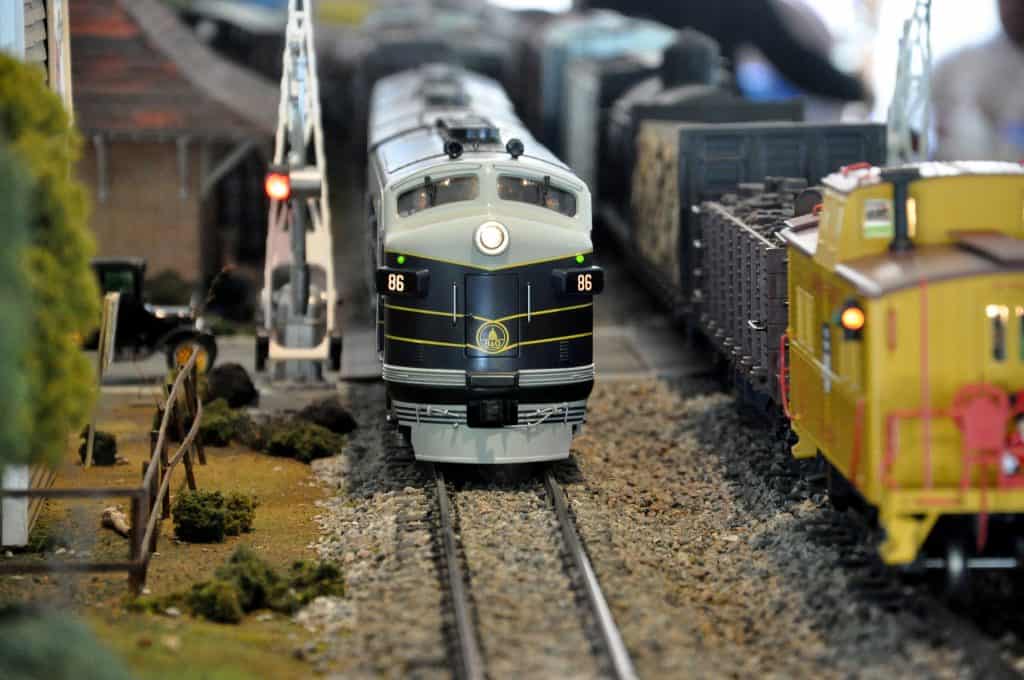
How to get started with model trains
So now you have a good enough idea about model trains and you’re ready to dive in right? Still not 100% sure how to get started though? Here’s a little checklist:
- Find an adequate spot for your model train layout. This is normally a spot in your house, basement or garage you can leave set up for quite some time.
- Using that knowledge, work out what kind of scale you want to build. Out in your garden, think about a G scale layout. If you’ve got a 6×4 foot area available, think about HO scale because it’s the most popular and you have room. Only got the size of a coffee table available, N or Z will let you pack the most punch that way.
- Next, think about the kind of theme you want. This is what trains you’re hoping to run, what kind of year it will be, what scenery you want to use etc.
- Now, go buy everything! If you’re still not 100% sure what you want, try visiting your local hobby shop and having a chat. They’re always super helpful and have seen it all before. If you know what you want, try somewhere like Amazon or that specific brand’s website.
- And finally, start building! This is the fun part. There’s not much else to add for this step as every person’s layout is going to be different. If you’re a beginner, embrace the little mistakes you’ll make early on, as you’ll only improve. And if you don’t know how to do something specific, Google, Youtube and Forums are your best friend!
What voltage do model trains normally run on?
When running your electric model train, the most common setup is to connect two wires to your track. The current run-up one wire and track to the train, then back down the other side, forming a loop.
The voltage will vary a little depending on the different scales and models so it’s best to check the specifications of each train before you run it. As an average, scales like O and G tend to run about 18v, while something tiny like N and Z run at around 12v. If you’re running multiple trains using a DCC train control kit, most of them will say to use around 22-25v just to make sure everything runs smooth.
What does DCC mean?
DCC stands for Digital Command Control. If running two wires to your track is considered an analogue way to do things, this is the digital version. It’s even in the name!
A DCC train control kit sits in between your power unit and the train tracks and sends signals to little ‘decoders’ or brains inside each train. These Decoders interpret the digital message and make the train do the corresponding things, such as; speed up, slow down, brake, reverse, blow the horn or whistle, and even turn the lights on or off. This is a big change from just having an on/off switch like the analogue method. The only problem with DCC units is that it can get fairly pricey, fairly quickly, so it’s best to wait until you’re past that initial beginner stage.
Check out our post if you want to know how to set up your own DCC Train Control unit!
What are some good model train layouts for small spaces?
Here are our top 3 picks for a model train layout for a small space. These are all designed using SCARM (Simple Computer Aided Railroad Modeller). It’s sort of an industry standard planner, that you can input what track sets you own and build a layout. I.e if you have Bachmann and Kato rail pieces, you can build a layout with just those pieces.
For these 3 small layouts, they’re all roughly 2×1 meter, or 6×3 foot, which should be small enough for your study or a bit of spare space.
- A super clean oval shaped layout is something that you can’t go wrong with. The centre section forks and allows for multiple trains to run on the line, as well as giving you somewhere to store your trains still in view while you run the others. A great beginner layout.

- This is basically the same as the track above, but an intermediate version of it. It’s still in the oval layout, just has more loops and a few different turnouts for an interesting experience. This definitely works well once you’ve got a few more track parts lying around and you’re ready to step it up a notch!
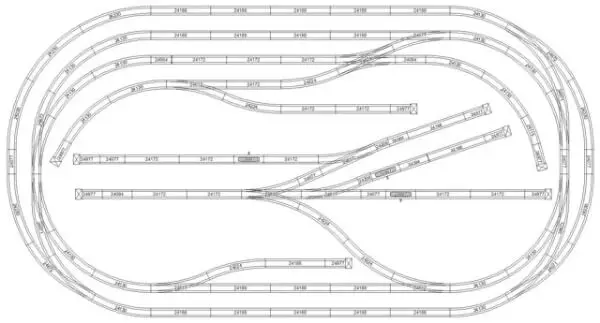
- Probably the most complex of the small layouts we’ve got here, this one has a more advanced version again of the ones previous. This one runs two main-lines, has two train stations as well as a yard in the middle for storing your train sets.

What are some good model train layouts for big spaces?
Same rules apply as above for our big layouts, although in this instance we’ve defined our top 3 big layouts as anything bigger than 2×1 meters or 6×3 foot, which is probably going to need it’s own basement or garage setup.
- A good beginners layout for a bigger track, this L shaped loop allows for 2 or more trains to run simultaneously around the loop and not get stuck when timed correctly, as well as the yard in the middle for easy train storage when they’re not running. Plenty of space means plenty of scenery opportunities on this board.
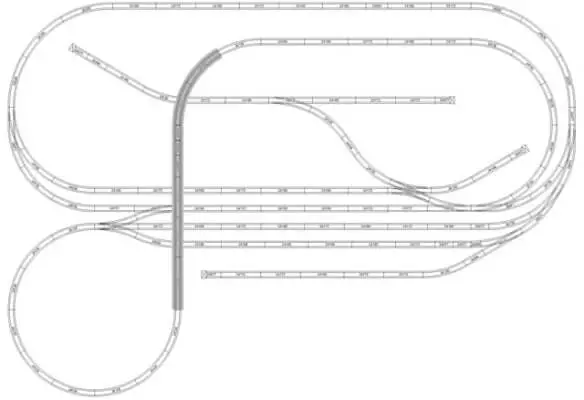
- A more complex L shaped double loop, this one is the intermediate version of the one above. A bigger yard and more track means you should have a few different kits by now and want something bigger and better. This will do that! The two main lines, and two loops mean you can run multiple locomotives at once if you want.
![The Ultimate Model Trains Guide! - [Updated 2022] 2 Marklin model Train Layout](https://myhobbymodels.com/wp-content/uploads/2018/11/Marklin_C-Gleis_260x180-640.jpg)
- Another L shaped track with some interesting loops, this is the advanced version of #2, just because there are some crossover sections that will need a watchful eye if you’re running multiple trains. The beauty of an L shaped track like this is in the future if you want to expand, you can easily brand of and fill in the empty section down the bottom with it’s own loop or yard!
![The Ultimate Model Trains Guide! - [Updated 2022] 3 O Gauge Elbante Train Layout](https://myhobbymodels.com/wp-content/uploads/2018/11/SCARM-O-gauge_Elbante-8x12-track-plan-13a-640.jpg)
What’s the best place to buy model trains and accessories?
There are a number of awesome places to purchase model trains and their accessories. Physically, you should always start with your local hobby shop. Not only are they a wealth of information on many tasks, but it doesn’t hurt to support local as well! Plus, it also means that you can see the train in person before buying it if you’re not sure what you want exactly. Other good places to buy are at local meetups or events. People often go there to show off their collections, and will often have trains there that are collecting dust they want to offload.
Online, there are plenty of amazing stores, the biggest and best being Amazon. Most of the bigger brands all sell through Amazon, so it’s a neat way to be able to check everything under one website, without having a million websites open.
Alternatively, if you know exactly what you’re after, you could always visit that brands website to see what they can offer.
Also online, you should absolutely check out websites like Ebay.com. They don’t just do auctions, they have stores that sell through their site and are often more competitive than Amazon.
What’s the number one train set a beginner should start with?
So, this question can be a little bit complicated, once again depending on what people want. Different scales, themes and preference for train sets can all come into this. Only have enough space for N scale and only like British trains, well your first set shouldn’t be a G scale American freight train no matter how good it is for beginners. If you don’t enjoy your first locomotive experience, you probably won’t stick with the hobby, and never experience just how good it really is!
But what if you don’t know what you want to get? You just know you want a model train. Well, here’s our pick!
[amazon box=” B004NHDW1K “]Why you may ask?
Well, Bachmann is a staple brand in the industry. Like we talked about above, they’re the biggest manufacturer in the world of model trains, so they know how to do it right.
This set is HO scale, which is also the most popular – it means you’ll be able to find all manner of accessories easily and affordably.
The Bachmann Rail Chief kit has everything you’re going to need to start your first layout. It comes with 5 different cars and a bunch of different accessories:
- EMD GP40 diesel locomotive (with operating headlight)
- Open quad hopper
- Gondola
- Steel reefer
- Off-centre caboose
- Straight and Curved rail-tracks
- Powerpacks, speed throttle, and couplers to connect to everything
- As well as a signal bridge, 36 people figures, 24 telephone poles and 48 railroad and street signs
Because it comes with so much, you can really get a good feel for how a model train layout will feel in your setting, and it’s a perfect platform to continue to grow and expand!
The only real con to this set is because it’s a little on the cheaper side, you might need to do a little filing down of some of the plastic joins to have it looking smooth. It’s just a byproduct of a cheaper mould, unfortunately, and is easily remedied with a nail file or running a scalpel along them.
Want a train but just not this one? Read our Best Model Train Guide here for more ideas.
How do I build those cool mountains, bridges and sceneries?
So, there’s nothing better than having a fully set up model train layout set up. Well, that is until you want to make your layout more complex, cooler and more eye-catching. That’s where things like bridges and tunnels come into play, amongst other scenery details.
Both tunnels and bridges can be purchased, and it’s probably recommended for beginners rather than trying to scratch build one yourself! At least with a purchased bridge from a reputable brand, you know it won’t break in half when your train is on it!
In both instances, it involves some landscaping and carving to make it work. Most layouts use a hard foam or polystyrene to build up the ground. They’re easily carvable, and after a bit of plaster-of-Paris, it can be painted to look like rocks, or sprinkled with grass or dirt!
So the first thing to do would be to work out roughly where you want your tunnel or bridge to go. This is always a good step in your initial layout ideas, but if you’re just now thinking about it, you might have to move some stuff.
Next, purchase whatever model is the most cost-effective/ the right size/ looks right to you! From there, you basically carve into the ground for your bridge, or add foam over the top of your tunnel, and continue to landscape from there.
It’s not much different from building mountains, valleys or rivers through your scene. The only thing you need to remember is to make sure that your train has enough clearance to go through the tunnel, and that your bridge tracks line up with the rest of your railway!
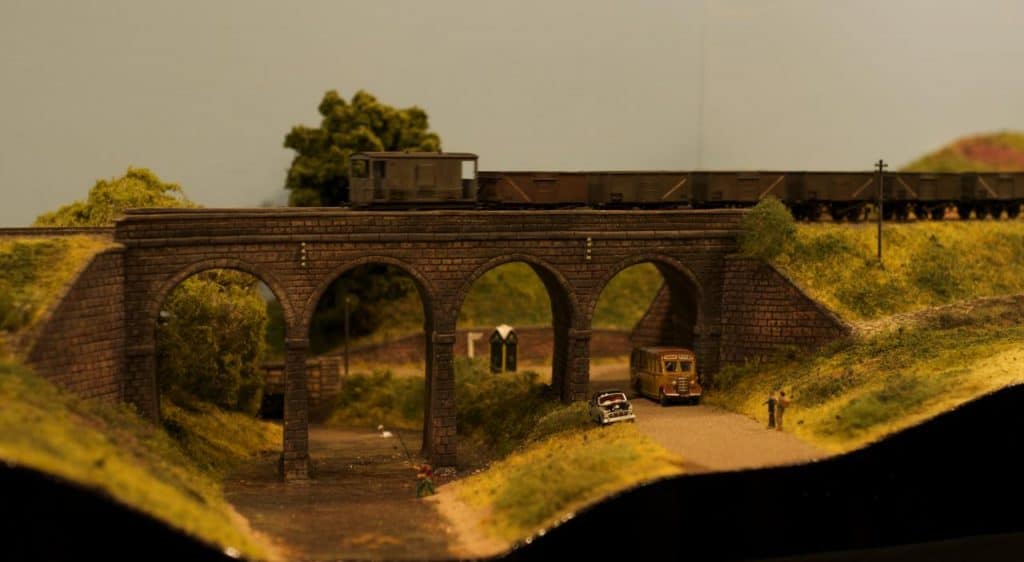
What are some of the common train track definitions?
So there are tons of different words that you might not be familiar with when you start getting into model railroading, and we’d be here forever if we laid them all out. But here’s a collection of some of the more popular ones that you should be familiar about to start with:
- Code: How high a rail track is down to a thousandth of an inch – Code 70 would be 0.70 inches tall etc.
- All-in-one track: A track that also includes the roadbed and ballast. So kind of an all in one set of track.
- Sectional track: Pieces of short, straight track. The same as all-in-one minus the roadbed and ballast.
- Turnouts: Turnouts are sometimes called a switch because they’re the part that switches from one track to another. They’re normally called turnouts because a switch is also used in electrics, so it helps avoid confusion.
- Flexitrack: Flexitrack is exactly what it sounds like. It’s almost like tape that you can lay down or bend, similar to sectional track, but obviously, flexible.
- Ballast: Ballast is all the rock or gravel that you see in between the rails of a track.
- Block: Blocks are an electrically isolated section of track that’s often used for controlling a train. Sometimes they’ll make them break or reverse, or whatever else you want it to do that doesn’t interfere with the main line.
- Crossing: You should be familiar with this in everyday life. They’re sections of track that cross a road another piece of track.
- Gantlet Track: These are overlapping tracks that share the same roadbed, and are used to make sure a train can pass through something narrow like a bridge, tunnel or valley.
- Roadbed: This is the dirt buildup that is under a track to help keep it up off the ground.
- Yard: The yard is an area with a lot of different ends of track where you can store and sort all your trains
What are some of the common model train definitions?
Same as with train track definitions, there are hundreds of different words and definitions
- Caboose: The caboose is the car, normally at the back of the train, that carries all the crew. Sometimes they’re called the buggy, cabin, way car and a whole host of other names.
- Classification Lights: These are the lights at the front of a train that tell you what kind of train it is. White means its an extra train on the tracks and green means another section of the train is still coming. There’s a host of different colour codes so take the time to look them up if you want to be super accurate!
- Coupler: This is the part that joins different trains, cars and locomotives together.
- Deadhead: Normally a passenger car that is attached to a train, but is riding totally empty.
- Head End Cars: Mail, baggage and express cars that run at the front of a passenger car.
- Helper: Helpers are locomotives that get added to a train set to help it get up a steep incline.
- Slug: A weighted locomotive unit with traction motors to help a diesel locomotive have additional traction force during slippery conditions.
- Throttle: This is the control unit that controls the speed and direction a train moves in.
- Unit: A unit is just a single (normally diesel) locomotive.
What time period do I set my layout in?
This is totally a personal preference thing. The beauty of a model train layout is that you’re in control and you can do whatever you want! Still, that doesn’t answer your question.
So what time period should your model train layout be in?
Well, a general rule of thumb is to either make it a neutral, slightly modern layout or a totally themed track like an 1800’s wild west.
So why a slightly modern layout? Well, a lot of older trains still run today, and they don’t look out of place. So having a layout that’s adorned in 80’s, 90’s or 00’s buildings and accessories would still look fine for a train from the 50’s or 60’s. But, if you try and put a modern-day Amtrack freight train in a British 1920’s setting, it’s going to stick out like a sore thumb!
So just bear in mind old trains can run in new settings, but not the other way around. That is unless you’re trying to recreate Doc Browns Back to the Future train in the Wild West!
That’s why if you’re building a themed layout, such as the Wild West in the 1800’s, or WW1 British train layout, every single detail needs to be accurate to make sure that it’s all cohesive. Of course, it’s a lot more work, and can be more expensive depending on the niche quality of the pieces, but they do look amazing.
So it’s totally up to you in this setting, although for beginners we’d recommend that neutral layout. It lets you have a feel for a variety of different trains like freighters, passenger cars, and even different nationality locomotives without looking too out of place.
How to clean and maintain your model trains
Model train maintenance is a pretty big part of owning model trains, and it’s a super important part. Luckily, it’s often not an arduous task if you do it semi-regularly! There are a few different ways to clean your locomotives and layouts because there are a number of moving parts.
- Your wheels are going to be one of the dirtiest parts of your whole set. As the dust settles on your model train layout over time, and then your locomotive runs over it, it’ll pick up dirt, grime and dust.
To clean it, you just need to get a cloth, dampen it with isopropyl alcohol and lay it over a stretch of sectional track. Then, just holding them, run your train over the top if it, like you’re pushing it along the track. The alcohol will stick to the dirt and they’ll be clean in no time! - Tidy up those tracks! Same as on the track, in between the joints of your track parts gunk and debris will build up over time. This can make your trains dirty, and in worse case scenarios derail them.
The easy fix for this is to just take a pair of tweezers and pluck out all that dirt and grime. If the tops of your tracks are a bit worse for wear, you can take a cotton bud or cotton tip dipped in Isopropyl alcohol and run it over the top. - Your locomotives, cabs and units are all going to need regular maintenance as well. Hornby recommends oiling them every 100 hours of run time, or roughly every 6 months. Although if it’s making louder than usual noises, oil at your leisure. This is as simple as taking so oil or lubricant (make sure it’s for engines and moving parts) and applying it to the wheels and gears until it runs smoothly and makes little to no noise.
- There are other types of maintenance that occur on your layout, and for specific things, you’ll need to have a poke around forums to find someone else that’s had a similar problem. Things like your static grass coming off, or parts moving can be easily fixed with some common sense, but a weird whistle from your expensive locomotive you can’t quick work out might need a trip to your local hobby shop!
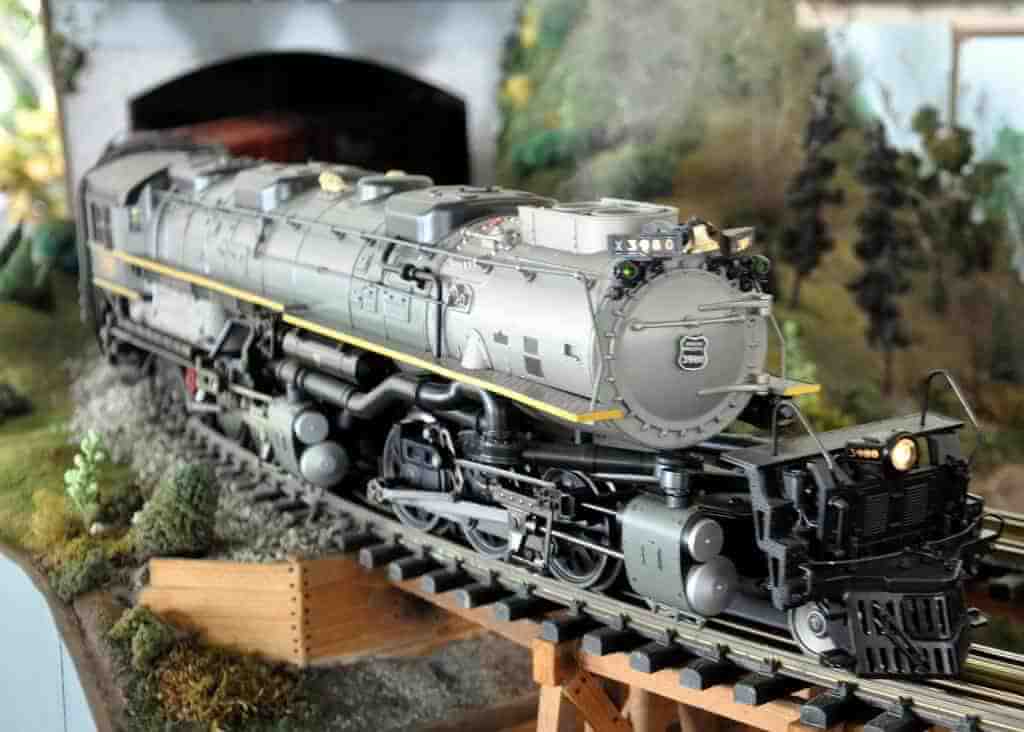
Are model trains a dying hobby?
No, not at all, is the short answer! In general, the model train hobby tends to skew towards an older demographic of enthusiasts, and one that’s not as cheap as other hobbies either.
Like every trend that exists, the craze for it comes and goes. While it is true to some extent that the charm for collecting model trains as a hobby has actually receded in the last couple of years, it definitely hasn’t gone altogether. And its cyclical nature can be seen in the popularity of model train diorama videos by the likes of Luke Towan on YouTube!
In the case of any hobby, it falls upon the younger generation to carry it forward after veterans have shared these experiences and had their time. But when it comes to model trains, the hobby itself is quite time-consuming and expensive.
In this modern, fast-paced world, people just don’t have the time or resources to invest in such an extensive hobby. They are more attracted to affordable and shorter forms of entertainment.
Just to put it in an example, a yearly subscription to Netflix costs less than a model train setup these days. So there definitely are a number of factors to consider why the hobby might not be as popular as it once was.
Now, despite this, the model train community is still incredibly strong, with regular meet-ups, events and a thriving online community. A lot of hobbies are cyclical in nature, and I’d bet good money that you start to see a resurgence in the next decade.
Tips for the best model train experience
- Voltage drop: What’s a voltage drop? Well, you’ve set up your brand new track but your trains running super slow and your lights all seem really dim? That’s probably a voltage drop! It’s a fancy way of saying that too many things are trying to use the power, so you might need to take some stuff away or get a bigger power unit!
- Keep your tracks off the floor: In most instances anyway. Obviously, if you’re down on the floor playing with your kids or just working out a layout, go for it!
But, if it’s a layout you plan on working on for ages, put it on a table. You’re less likely to stand on it, or have your kids knock over bits, or have your dog bowl it over etc. It’s not something everyone thinks about, and then it’s a pain to carefully move everything later on. - The train keeps coming off the track: So your train keeps coming off the track? Well, it’s either one of two things. Either it’s your train or your track. The easiest way to work this out is this: If that specific train keeps coming off the rails at random locations, the wheels might be bent and its the train. If multiple trains come off at the same point,m your bend might be too sharp and you just need to open your track up a little.
- KISS (keep it simple stupid): This tip is in the title. Start simple, get more complicated. Don’t make your first ever build a multi-story, bridge/tunnel combo with a $1000 DCC train control unit with all the bells and whistles. Set up a basic layout and make sure your train goes around it. Then add some buildings and scenery. Now, start moving a few bits and pieces around if you want. Just start simple and work your way up!
- Observation – Make it realistic: You know the easiest way to make a model train layout stand out from the rest? Attention to detail. I’m not just talking about having a cool set of kit buildings and some fancy detailed trains. I’m talking about getting a marker and drawing that bit of graffiti on the back of the train shed, or modelling the newspaper and trash that’s piled up in a corner of a yard, or the little landslide from your cliff, or the weathered rust you’ve painted onto your older model caboose. Actively look around you next time you’re out and see what little details you could add to really give your layout a sense of realism.
- It’s your model train layout, do what you want!: This is important and don’t forget it, no matter what anyone tells you. It’s your trains, your layout, your locomotives, your scenery and your hard work. If you want to take an airbrush and make your Lionel train a fluoro pink, go for it. Want to just make Christmas layouts in June, go for it. It’s a hobby and one that’s meant to bring you joy. So do whatever makes you happy!
So now you’re all caught up to speed on electric trains, what’s next?
Well, consider taking a look at our Top Electric Trains Review post to get started!
Or alternatively, keep reading up on some of the best model train brands to further your knowledge.
Peter has been building model trains for longer than he can remember. An avid fan of HO and O scale this blog is a creative outlet to allow him to dive further into other scales and aspects of the model train community and hobby.
![The Ultimate Model Trains Guide! - [Updated 2022] 1 model train layout](https://myhobbymodels.com/wp-content/uploads/2018/11/5530549869_3bda9c774b_b.jpg)
Thanks for sharing!
Thank you so much! This has helped me tremendously. I haven’t started on any model train or track or building, I have just been looking around for information and tips before I buy anything or break something. This has answered all or my thoughts.
What a great article. An excellent common sense approach to the wonderful of model trains. Many thanks.
There are a few basic notes and numbers that need correcting.
1. The two most popular scales worldwide are HO and N scale. O scale, whether the Lionel toy train type or true O scale version, is a distant third.
2. HO gauge track is 16.5mm. That’s 0.65″, NOT 1.75″, which would be half an inch wider than O scale!
3. Under track definitions: Rail code: Code 70 rail is .070″ inches – 70/1000 of an inch high, NOT 0.70, which is almost 3/4 of an inch! That’s HUGE – even in G scale! It’s even big for most of the “ride-on” trains at live steam clubs!
4. Choosing a time period: You mention “an Amtrack (sic!) freight train”. Amtrak is a passenger train operator in The United States. It would indeed by very obvious if ANYONE, ANYWHERE operated an Amtrak (note the correct spelling: there’s no”c” in Amtrak) freight train.
The diagrams for the various layouts are not visible. Is there a way of displaying them?
Thanks
Roger
Hey Roger,
Looks like theres a problem on my end. I’ll get to fixing it as soon as possible!
Thanks, Peter. Very helpful article for those of us who have more questions than ideas.
I tried to email you but your contact link is broken and doesn’t work. Says there is an error. How does someone contact you? Thank you.
hi I am a novice and have just built a plywood base for my proposed model train layout. I am now considering covering the whole table in some form of foam board. Is this recommended or should i just start laying track on the ply ?
Thanks for writing the most accessible, un-snobbish, articles for those of us getting started. Excellent information that is to the point and makes learning about model railroading fun.
Going to get into it just to haul my red line cars in circles
Love it